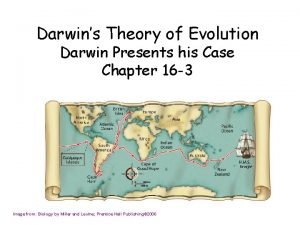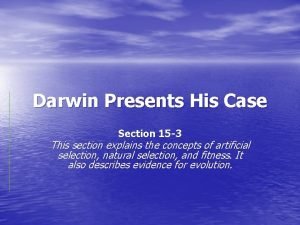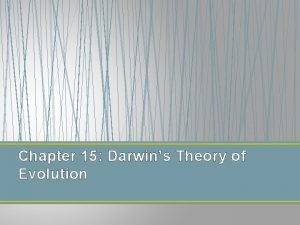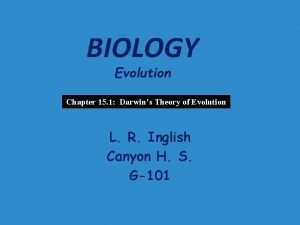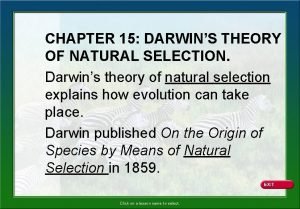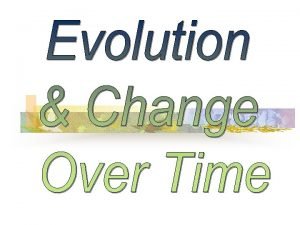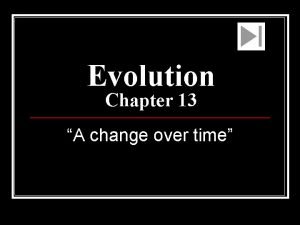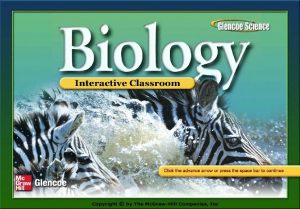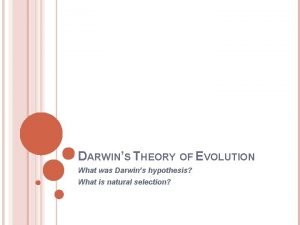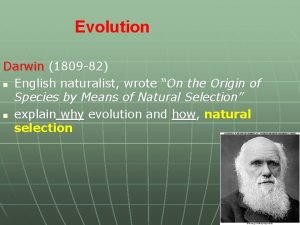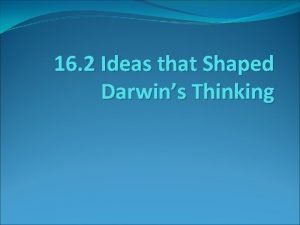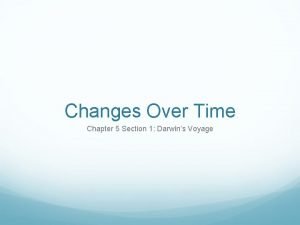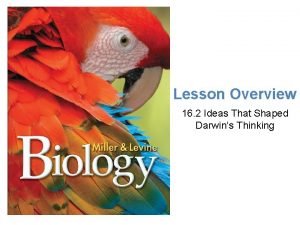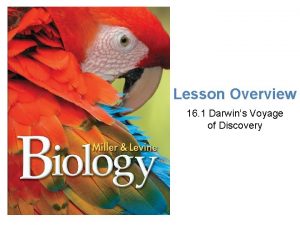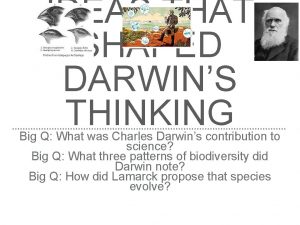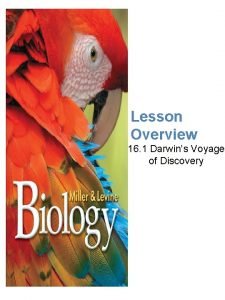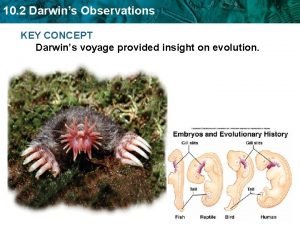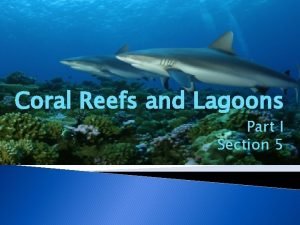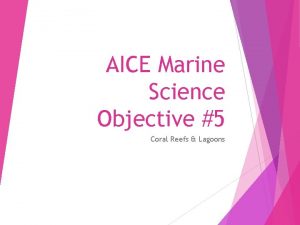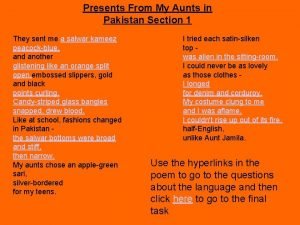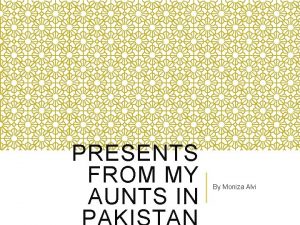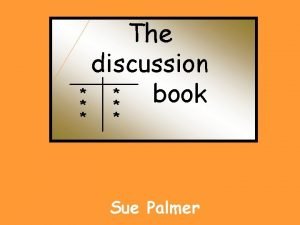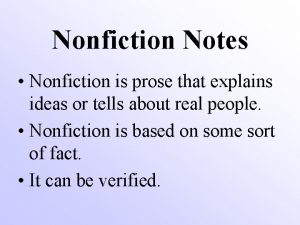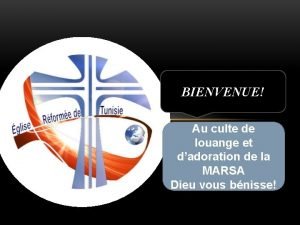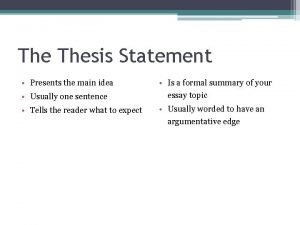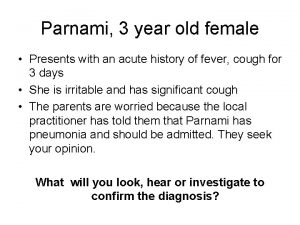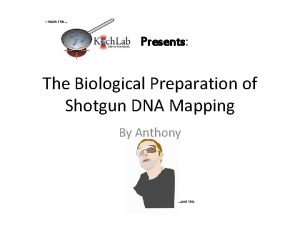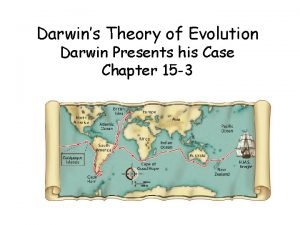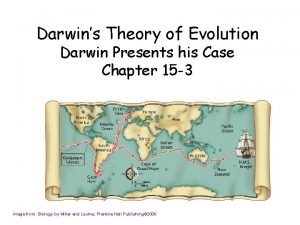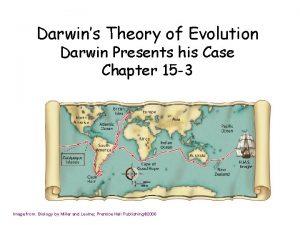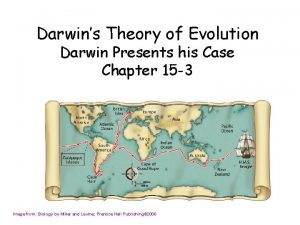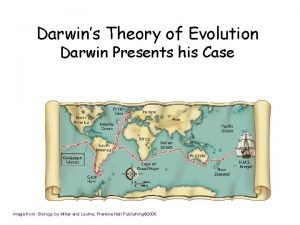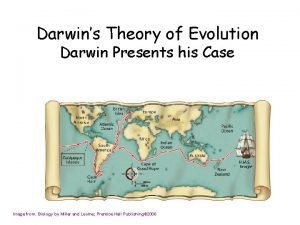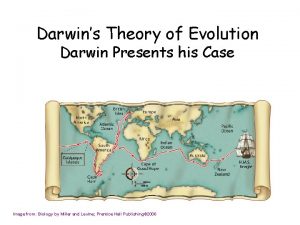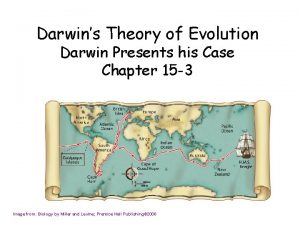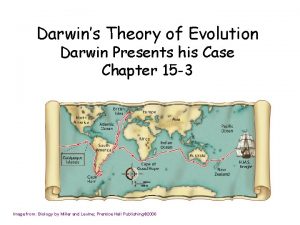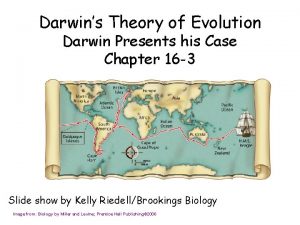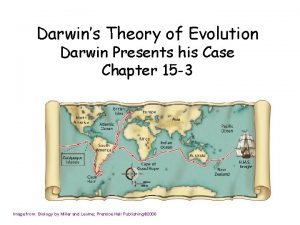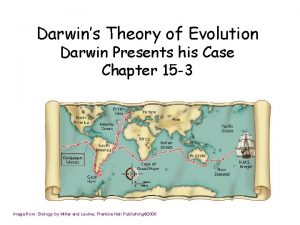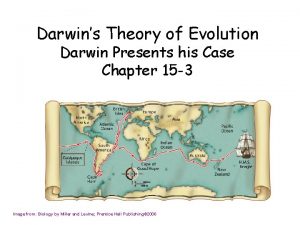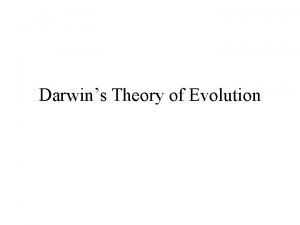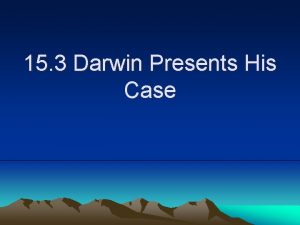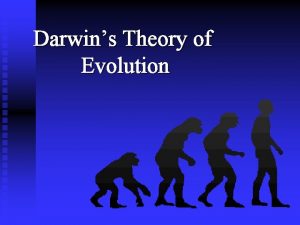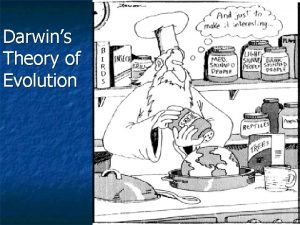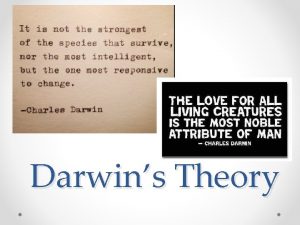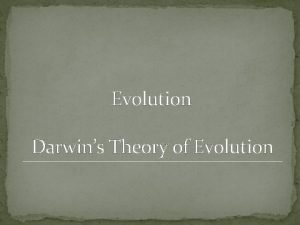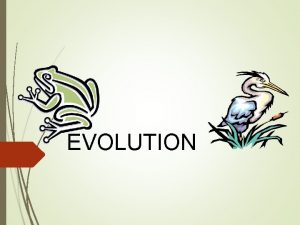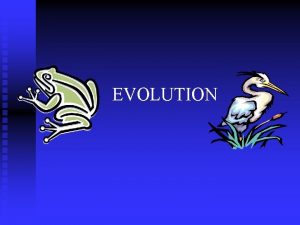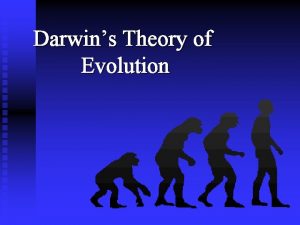Darwins Theory of Evolution Darwin Presents his Case






































- Slides: 38

Darwin’s Theory of Evolution Darwin Presents his Case Image from: Biology by Miller and Levine; Prentice Hall Publishing© 2006

WHAT IS DARWIN’S THEORY? Over time, NATURAL SELECTION results in changes in the inherited characteristics of a population. These changes increase a species’ fitness in its environment. How Does Evolution Really Work?

WHAT IS DARWIN’S THEORY? SURVIVAL OF THE FITTEST = Organisms which are better adapted to their environment tend to produce more offspring than organisms without those traits. http: //www. poster. net/bedard/bed 202. jpg

WHAT IS DARWIN’S THEORY? OVERPRODUCTION of OFFSPRING Capacity to over-reproduce seems characteristic of all species. http: //www. biospheres. com/photogallery 2 ag/images/ladybugs_jpg. jpg http: //atthecreation. com/DEER/too. many. deer. jpg

WHAT IS DARWIN’S THEORY? STRUGGLE FOR EXISTANCE means that members of each species must compete for food, space, and other resources. http: //www. wasatchcomputers. net/gallery/elk_fight. jpg

WHAT IS DARWIN’S THEORY? GENETIC VARIATION is found naturally in all populations Image from www. biologyzone. com http: //www 3. nationalgeographic. com/animals/images/primary/zebra-herd. jpg

WHAT IS DARWIN’S THEORY? Some organisms in a population are less likely to survive. http: //www. cartoonstock. com/newscartoons/cartoonists/rrs/lowres/rrsn 69 l. jpg

IMPORTANT TO REMEMBER ! • POPULATIONS evolve NOT INDIVIDUALS. • NATURAL SELECTION only works on heritable traits. • A trait that is favorable in one environment may be useless or detrimental in another.

WHAT IS DARWIN’S THEORY? DESCENT WITH MODIFICATION suggests that each species has descended with changes from other species over time. This idea suggests that all living species are related to each other and that all species, living and extinct, share a common ancestor.

EVIDENCE OF EVOLUTION: selection 1. Artificial ________ Fossil record 2. ________ Geographic Distribution 3. ________ Anatomical homologies 4. ________ Embryology 5. ________ Molecular homologies 6. ________ see Natural selection happen 7. Can ________

ARTIFICIAL SELECTION WORKS Nature provides the variation through mutation and sexual reproduction and humans select those traits that they find useful EX: We have selected for and bred cows to produce more milk, turkeys with more breast meat, etc. http: //www. pp 3 moo. com/hm 2 cow. jpg http: //lazerbrody. typepad. com/photos/uncategorized/turkey. gif

WE’VE DONE IT WITH PLANTS BIOLOGY by Campbell and Reece Prentice Hall Publishing© 2005

WE’VE DONE IT WITH ANIMALS If humans can select for beneficial traits, why can’t nature? If artificial selection can achieve so much change in relatively short time, why can’t major changes happen over thousands of generations? http: //www. windows. ucar. edu/earth/geology/images/dogs_sm. jpg

How Do We Know Evolution Happens? The Fossil Record provides evidence that organisms have changed over time. http: //www. bbc. co. uk/schools/gcsebitesize/img/bifossils. gif

If evolution has happened, we should be able to find evidence of evolution in the fossil record AND WE HAVE ! http: //en. wikipedia. org/wiki/Image: Tiktaalik_BW. jpg BBC Tiktaalik video http: //evolution. berkeley. edu/evosite/lines/IAtransitional. shtml

Lots of TRANSITIONAL FOSSILS have been found Scientific American; Dec 2005; Vol 293; p 100 -107

GEOGRAPHIC DISTRIBUTION = BIOGEOGRAPHY If Darwin’s theory is correct you would expect to find closely related yet different species living in a geographic region as they spread into nearby habitats and evolve. That’s EXACTLY what we do see!

http: //images. encarta. msn. com/xrefmedia/aencmed/targets/illus/ilt/T 014608 A. gif GALAPAGOS FINCHES The beaks of Galapagos finches have adapted to eating a variety of foods

http: //www. newtonswindow. com/problem-solving. htm GALAPAGOS TORTOISES Intermediate vegetation Intermediate necks Little vegetation Long necks Image from: BIOLOGY by Miller and Levine; Prentice Hall Publisher© 2006 Lots of vegetation Short necks Tortoises adapted to different habitats as they spread from the mainland to the different islands. = DIVERGENT EVOLUTION = ADAPTIVE RADIATION

If Darwin’s theory is correct you would also expect to find different species living in far apart geographic regions but similar habitats becoming more alike as they adapt to similar environments. That’s EXACTLY what we do see!

BOTH LIVE IN FOREST ECOSYSTEMS Adapted to similar environments, but evolved independently from different ancestors. SUGAR GLIDER in Australia is a marsupial more closely related to Kangaroos than North American FLYING SQUIRRELS because its ancestors were marsupials.

http: //www. flmnh. ufl. edu/fish/gallery/descript/Tiger. Shark/scars. JPG http: //news. bbc. co. uk/2/shared/spl/hi/guides/456900/456973/html/nn 1 page 1. stm Whales and sharks have a similar body design even though they are very different organisms (one is a fish; the other, a mammal) because they have independently adapted to living in a similar environment. = CONVERGENT EVOLUTION

HOMOLOGOUS STRUCTURESForelimbs of all mammals share same arrangement of bones that can be traced to same embryological origin BIOLOGY by Campbell and Reece Prentice Hall Publishing© 2005

EVOLUTION explains why certain characteristics in related species have an Section 15 -3 underlying similarity. Turtle Alligator Ancient lobe-finned fish Bird Mammal

VESTIGIAL ORGANS Some homologous structures are vestigial and have no useful function even though they are still present. Examples: Hipbones and pelvis in whales and boa constrictors Cecum (appendix) in humans Skink legs http: //www. txtwriter. com/backgrounders/Evolution/EVpage 12. html

Most mammals have a pouch between their small and large intestine that contains bacteria to digest plants called a cecum. In humans the cecum is shrunken and unused. It is our appendix http: //www. medicalgeo. com/images/appendix. gif

EMBRYOLOGY Development of vertebrate embryos follows same path Image from: http: //calspace. ucsd. edu/virtualmuseum/litu/03_3. shtml

MOLECULAR HOMOLOGIES • All life forms share same genetic machinery (DNA & RNA) • Universal genetic code • Important genes share highly conserved sequences

Similarities in protein sequences suggests similarities in DNA Image from: Modern Biology by Holt, Rinehart, and Winston

MOLECULAR HOMOLOGIES Similarities in DNA and protein sequences suggest relatedness Image from: BIOLOGY AP EDITION by Campbell and Reece; Prentice Hall Publishing© 2005

Human- 46 chromosomes Chimpanzee- 48 chromosomes Similarities in karyotypes suggest an evolutionary relationship Human: http: //www. nationmaster. com/wikimir/images/upload. wikimedia. org/wikipedia/en/thumb/1/18/300 px-Human_karyogram. png Chimpanzee: Middle School Life Science , published by Kendall/Hunt.

Human- 46 chromosomes Chimpanzee- 48 chromosomes Even differences show relatedness Chimpanzees have 2 smaller chromosome pairs we don’t have Humans have 1 larger chromosome pair (#2) they don’t have. Human: http: //www. nationmaster. com/wikimir/images/upload. wikimedia. org/wikipedia/en/thumb/1/18/300 px-Human_karyogram. png Chimpanzee: Middle School Life Science , published by Kendall/Hunt.

Remember: Protective TELOMERE sequences found at ends of chromosomes http: //joannenova. com. au/Speaking/Morslids. html

2. TELOMERES IN MIDDLE Human chromosome is only human chromosome that has telomere sequences at the ends BUT ALSO IN THE MIDDLE. . . suggesting it was made by joining two other chromosomes together. → → → http: //www. evolutionpages. com/chromosome_2. htm

EXTRA CENTROMERE _________ Chromosome #2 has a second inactive centromere region. . . suggesting it was made by joining two other chromosomes together. → Which chromosomes? http: //www. evolutionpages. com/chromosome_2. htm

BANDING PATTERN MATCHES ____________ If you take the two smaller chromosomes they have that we don’t, and place them end to end, the banding pattern is identical to human chromosome #2 http: //www. evolutionpages. com/chromosome_2. htm

Slide by Kim Foglia@ http: //www. explorebiology. com/

Slide by Kim Foglia@www. biologyzone. com
 16 3 darwin presents his case answer key
16 3 darwin presents his case answer key Section 15-3 darwin presents his case answers
Section 15-3 darwin presents his case answers Chapter 17 darwin's theory of evolution
Chapter 17 darwin's theory of evolution Chapter 15 darwin's theory of evolution
Chapter 15 darwin's theory of evolution Chapter 15 darwin's theory of evolution section review 15-1
Chapter 15 darwin's theory of evolution section review 15-1 Chapter 15 darwin's theory of evolution section 15-1
Chapter 15 darwin's theory of evolution section 15-1 Explain the theory of evolution
Explain the theory of evolution Chapter 15 darwin's theory of evolution
Chapter 15 darwin's theory of evolution Homologous structures examples
Homologous structures examples Endosymbiont theory
Endosymbiont theory Chapter 15 section 1 darwins theory of natural selection
Chapter 15 section 1 darwins theory of natural selection Darwin's hypothesis
Darwin's hypothesis H
H Best worst and average case
Best worst and average case Ideas that shaped darwins thinking
Ideas that shaped darwins thinking Section 15-2 ideas that shaped darwin's thinking
Section 15-2 ideas that shaped darwin's thinking Section 2 darwins observations study guide a
Section 2 darwins observations study guide a Ideas that shaped darwins thinking
Ideas that shaped darwins thinking Lesson 1 darwins voyage of discovery
Lesson 1 darwins voyage of discovery Ideas that shaped darwin's thinking answer key
Ideas that shaped darwin's thinking answer key Lesson 1 darwins voyage of discovery
Lesson 1 darwins voyage of discovery Darwins observations
Darwins observations Dyoutu
Dyoutu Aice marine science
Aice marine science Cause and effect text structure keywords
Cause and effect text structure keywords Presents from my aunts in pakistan poem
Presents from my aunts in pakistan poem Presents from my aunt in pakistan
Presents from my aunt in pakistan Sally elatta presents on business agility
Sally elatta presents on business agility Zids and zods answers
Zids and zods answers A text that presents one side of the topic
A text that presents one side of the topic Gurmit paid £21 for five presents
Gurmit paid £21 for five presents Prose writing that presents and explains ideas
Prose writing that presents and explains ideas Prose writing that presents and explains ideas
Prose writing that presents and explains ideas Zids and zods
Zids and zods Where does “snowflake girl” help to deliver presents?
Where does “snowflake girl” help to deliver presents? Mot de bienvenue au culte d'adoration
Mot de bienvenue au culte d'adoration Which statement presents the main idea of the text
Which statement presents the main idea of the text A 26 year old female presents
A 26 year old female presents This presents
This presents
